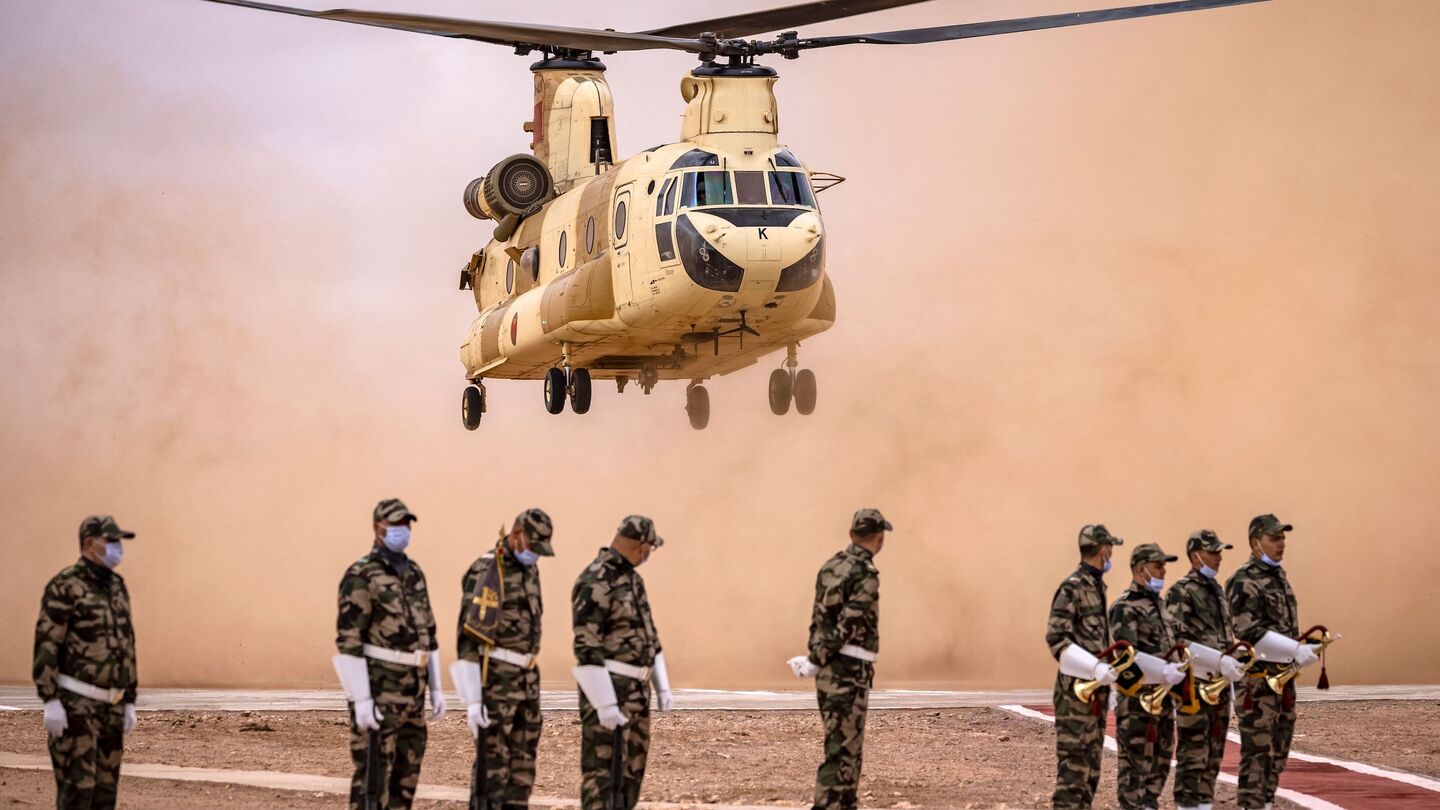
Supply and demand: North African military expenditures raise stakes for global defense suppliers
July 2023 Al-Monitor PRO Trend Report
3467 words
Introduction
As a column of Wagner mutineers bore down on Moscow in June 2023, imperiling President Vladimir Putin’s grip on power, Russia’s capital was only a few days removed from receiving a far more welcome guest: Algerian President Abdelmadjid Tebboune, who arrived in Moscow on June 13 for a state visit.
It wasn’t without consequence. At a time when Putin has few friends left following Russia’s invasion of Ukraine in 2022, Algeria has remained committed to its strategic partnership with Russia, and the two leaders pledged to deepen that relationship during Tebboune’s visit. "Algeria is a key partner for us in the Arab world and in Africa," Putin said then, adding that Russia wanted to strengthen already-strong military ties with the North African country, which imports around 75% of its arms from Russia.
Yet, this strategic partnership’s future looks increasingly complex following Wagner’s failed revolt, which further called into question Russia’s ability to serve as a reliable partner and weapons supplier at a crucial moment. Algeria’s rivalry with Morocco has escalated recently, amplifying a long-running arms race, with Rabat loading up on Western weaponry as Algiers sizes up Moscow’s support. It’s a glimpse of the geopolitical complexity at play in North Africa — a region on the frontlines of a new era of competition in the global arms trade.
North Africa features three countries that rank among the world’s top 30 arms importers, but the region currently lacks any significant arms exporters, according to data from the Stockholm International Peace Research Institute (SIPRI). However, local governments seek to change that, headlined by Egypt’s ambitions to revive its domestic defense manufacturing capabilities. That comes alongside a unique situation in conflict-ridden Libya, which has become an incubator for foreign weaponry and private military companies. Combine all this and North Africa is a region where global superpowers and regional players alike are all set to compete for defense deals, partnerships and influence.
1. State of Play: Supply and Demand
North African nations spent an estimated $19.1 billion on defense in 2022, down 3.2% from 2021 and equal to 0.9% of all global military expenditures, according to SIPRI data. That came as neighboring Middle East countries spent an estimated $184 billion in 2022, a 3.2% increase over 2021 and equal to 8.2% of worldwide spending.
This stark contrast in military spending comes alongside major differences in defense industry activity across these two interlinked regions, which are generally lumped under the umbrella of “MENA.” As outlined in Al-Monitor's June 2023 trend report on the Middle East’s defense industry, the reigning trends dictating military spending and industry development from Ankara to Abu Dhabi are strategic autonomy and self-reliance. That’s seeing Gulf states seek to emulate Turkey and Israel, the region’s defense industry powerhouses. That comes as nearby Egypt’s defense sector has a long and storied history, but production had languished compared to regional peers in recent decades — leaving North Africa bereft of key industry players.
However, Cairo’s appetite for weaponry hasn’t declined: Egypt is currently the world’s 6th largest weapons importer, accounting for a 4.5% share of global arms imports between 2018-2022, according to SIPRI. Egypt has focused on modernizing its military in the decade since President Abdel Fattah al-Sisi came to power. The military has also played an outsized role in the economy, controlling assets across many sectors.
Notably, Egypt is a prolific weapons importer with a fairly modest defense budget. Egypt’s defense market budget is worth $9 billion in 2023, according to GlobalData. Cairo’s official military expenditures lag well behind MENA’s other major weapons importers, but in the region Egypt’s arms purchases only trail Saudi Arabia — a country that had a $75 billion military budget in 2022. That indicates that some of Egypt’s funding for arms procurement comes from outside the regular military budget, unlike most other countries. Russia was Egypt’s top arms supplier between 2018-2022 with a 34% market share, followed by Italy’s 19% and France’s 19%. This represents a major shift: between 2000-2009, the US provided 75% of Egypt’s total arms imports, according to SIPRI.
That said, its domestic defense industry is now enjoying newfound momentum. “There seems to be a more deliberate effort to achieve qualitative improvements in the defense industry by focusing on a few specific products that it can realistically upgrade and manufacture with a higher level of local content,” Yezid Sayigh, a senior fellow at the Malcolm H. Kerr Carnegie Middle East Center, told Al-Monitor. Armored cars are a good example, notes Sayigh.
In 2020, Egypt announced the launch of a three-year weapons manufacturing plan aimed at achieving self-sufficiency and boosting exports, underpinned by an investment of about 7.5 billion Egyptian pounds ($479 million). “After its implementation, Egypt will not import a single round of ammunition,” said Egypt's then Minister of State for Military Production Mohamed al-Assar at the time. However, importing foreign technology remains key to domestic production. For instance, Egypt inked a $1.7 billion deal in 2022 for K9 howitzers from South Korea, an agreement that also included local production of the artillery system in Egypt.
This comes as Algeria is currently North Africa’s largest military spender, with the government doubling its defense budget in 2023 to $18 billion. That was equal to 4.8% of its GDP — a sizable share. This huge spending hike emerged after Algeria enjoyed surging energy prices in 2022 following Russia’s invasion of Ukraine.
SIPRI ranks Algeria as the world’s 18th-largest arms importer, with Russia its main supplier with a 73% market share of imports, followed by Germany’s 10% and France’s 5.2%. Meanwhile, Algeria’s indigenous defense industry is small, providing light weaponry around ground transport, explosives and warships, while relying on Russian and Chinese licensed arms, according to the International Trade Administration. However, recently the government has indicated it will further develop its local arms industry.
Algiers has also recently committed to diversifying arms procurement and has been building relationships with other suppliers. For instance, reports indicate Algerian and Italian military officials met in December 2022 and agreed to deepen ties between their respective defense industries. In February 2023, Algeria and the UAE discussed the possibility of establishing joint ventures in defense.
Algeria’s chief rival Morocco has a defense budget worth $6.1 billion in 2023, after allocating $5 billion to military spending in 2022. Morocco currently ranks as the world’s 29th largest weapons importer, with the United States commanding a 76% share, followed by France’s 15% and China’s 6.8%. These weapons flow to a large military that’s committed to modernization efforts, notes the International Trade Administration.
Guiding Morocco’s efforts is its 2030 modernization plan, which focuses on interoperability with the United States and NATO and includes $20 billion to these strategic objectives. Crucially, its plan includes a focus on establishing a local defense industry, including producing weapons for export. The United States continues to be a key source of advanced weapons: in April 2023, the Biden administration approved a $524 million sale of HIMARS mobile artillery systems to Morocco, along with a $250 million sale of guided precision air-to-ground bombs. If financialized, it would mark the first transfer of HIMARS to a North African country.
Meanwhile, Tunisia’s military expenditure has grown swiftly in recent years, reaching a record $1.25 billion in 2021, double what it was roughly a decade before. However, this comes as its close security partnership with the United States has faced headwinds amid the ongoing erosion of democracy in Tunisia.
US foreign military financing for Tunisia has been cut roughly in half, from $85 million in 2021 to $45 million in 2023, notes Sharan Grewal, an assistant professor at William & Mary and a nonresident fellow with the Brookings Institution. However, military aid cuts appear to have stabilized somewhat at this lower level. “Significant financing continues, as do weapons sales,” said Grewal.
Tunisia also retains its designation as a major non-Nato ally by the United States, which it received in 2015, a decision unlocking access to superior US weapons systems and training. However, Tunisia has also boosted defense industry cooperation with other players. In 2021, Turkey and Tunisia inked a cooperation agreement providing the basis for joint production and modernization of military and defense materiel.
Finally, Libya’s ongoing instability has influenced broader military spending and geopolitical maneuvering in MENA. The conflict-ridden state has served as a proving ground for an array of modern weaponry. For instance, Turkish Bayraktar drones saw use in Libya well before becoming famous in Ukraine. Libya has also been fertile ground for private military companies contracted by rival factions — headlined by Russia’s Wagner group, which has worked closely with Khalifa Hifter, commander of the Libyan National Army (LNA). That trend accelerated in 2019, when Wagner took an active combat role supporting the LNA, with Gulf players reportedly footing the bill for their services. Wagner has also used Libya as a forward base for activities in the Sahel.
2. An accelerating arms race?
On July 17, 2023, Israel recognized Morocco's sovereignty over Western Sahara — a major victory for Rabat’s pursuit of outside recognition for the contested area and a setback for Algeria. Crucially, the move could have significant implications for the ongoing arms race between the two rivals, with tensions already high even before Israel’s recognition.
The territorial dispute traces to the 1970s, when Spain withdrew from Western Sahara and it became caught between competing regional neighbors. A 1991 ceasefire agreement saw Rabat lay claim to 80% of Western Sahara, with the rest held by the Algiers-backed Polisario separatist movement. As such, Algiers and Rabat have each viewed the other as a primary security threat and have long developed military policies accordingly. Both have amassed sizable forces equipped to fight a conventional war with the other. However, both Algeria and Morocco had decreased major weapons purchases in the past decade.That now appears to be changing.
Hostility was already escalating even before Israel’s recognition, with Tebboune saying earlier in 2023 that Algeria had reached a “point of no return” in fraught relations with Morocco. That came after Morocco and Israel agreed to establish full diplomatic relations in 2020 as part of the US-brokered Abraham Accords. Crucially, that saw the United States agree to recognize Western Sahara as Moroccan territory as part of the normalization agreement. A year later, Algeria unilaterally severed diplomatic ties with Morocco.
Algeria has now raised the stakes by doubling its military budget to $18 billion in 2023, well above Morocco’s outlay. The adversaries represent a major source of arms deals, with Algeria and Morocco together accounting for 74% of all military spending in North Africa in 2022. Both often set procurement priorities to counter the other. Russia and the United States have been the main beneficiaries of these competing moves, but there’s an increasing likelihood that Algeria and Morocco will diversify their procurement relationships.
The situation for Algiers is becoming particularly complex, with access to its preferred source of weapons now increasingly in flux. Bogged down in Ukraine and burning through equipment, Russia’s ability to export weapons looks shaky. There are already signs Algiers is drifting away from Moscow: in November 2022, reports emerged that Algeria was set to sign a deal worth up to $17 billion for Russian weapons, including Sukhoi stealth aircraft, but this deal has yet to materialize and notably did not feature during Tebboune’s 2023 Moscow visit.
If Algeria shops around, China is a logical alternative at a time when Beijing is expanding its MENA footprint. However, defense deals did not feature during Tebboune’s official visit to China in July 2023, when Algiers and Beijing signed 19 cooperation agreements.
Meanwhile, Morocco must contend with the long approval timelines that feature in US defense deals, not to mention the political conditions Washington places on weapons sales. One option is to deepen connections with European suppliers, but another rising possibility is an expanded defense relationship with Israel.
Morocco and Israel have expanded security and intelligence ties since normalizing relations, including signing a bilateral security cooperation agreement in November 2021. Notably, Morocco purchased at least 150 drones from Israel’s BlueBird Aero Systems in 2022 to bolster its air defense capabilities. A portion of these drones will reportedly be built in Morocco. Also, in June 2023 the Israeli defense technology company Elbit Systems announced plans to open two sites in Morocco.
3. Outlook
• After boosting spending in 2023, North Africa’s top defense markets look set to continue increasing or maintain military expenditure in the short-term. That outlook largely centers on tensions between Morocco and Algeria, a rivalry that will continue influencing procurement priorities and dominate regional spending totals.
• That should see North Africa remain an important market for global weapons exporters. At a minimum, Algeria’s recent profits from elevated energy prices have given it newfound flexibility to boost military expenditure, making it a key market to watch — although this spending surge may be fleeting as oil revenues dry up.
•Shifting supplier relationships will be another trend to watch. Again the most intriguing candidate here is Algeria, which has already committed to diversify its defense partners at a time when Russia may prioritize production of arms for its own military. The case for diversification has only grown stronger during 2023.
• Riding a record defense budget, Algiers has a real opportunity to reduce dependence on Russia and growing leverage to negotiate defense deals on its terms. That’s also setting the stage for Algeria to build up its own defense industry.
• It remains to be seen whether Russia’s multi-billion dollar arms sale with Algeria will move forward as advertised. Regardless, Moscow is still positioned to provide the vast majority of Algeria’s weapons in coming years, but its share of imports should decline below 70%. It’s also possible that Russia’s market share in Egypt will erode further in coming years.
•Regarding Morocco, it’s likely that Rabat will continue challenging its archrival by increasing defense investments. That will see Moroccan reliance on US weapons continue even as it also diversifies procurement. Israel in particular looks set to ink new deals here amid deepening ties with the North African country.
•Meanwhile, US relations with Tunisia under Saied have certainly deteriorated, notes Grewal, but for now significant US financing and weapons sales continue. “That at least limits Tunisia's need to turn elsewhere,” said Grewal.
• Tunisia should also remain firmly within the US orbit despite military funding cuts. “Russia and China have had ample opportunity in the last two years to fill the void, but both are overstretched and neither view Tunisia as a priority,” said Grewal. “Most importantly, Tunisian military officers strongly prefer to ally with the West, as they have since independence.
• Although North African states will stay overwhelmingly reliant on imports, more investment should flow towards local defense industry development. Algeria currently has a major (and potentially fleeting) opportunity to build up its own defense industry. Morocco looks poised to make moves here too, while Egypt has demonstrated more political will to channel funding into weapons production.
• Foreign cooperation and knowledge transfer will be key to developing these capabilities, as local countries largely lack the R&D capabilities necessary to manufacture cutting-edge tech. That will see local governments actively engaging with a range of global players alongside making moves to court foreign investment.
• There are already plenty of indications that North African players will ink new cooperation agreements to boost local manufacturing, from Egypt potentially linking up with Renault to develop military vehicles to Algeria striking pacts with Italy to pursue joint production.
• That said, local ambitions to export weaponry look mostly aspirational in the near-term. Egypt is the leading example: “There is scope for exports, but these are likely to be modest, and certainly not enough to sustain significant growth or new investment,” said Sayigh. Egypt’s defense industry still produces very few items that are genuinely exportable, and its products will mainly be attractive for poor countries that cannot afford to be big customers, notes Sayigh.
• Plus, Egyptian products will have to compete with many others in the same categories, said Sayigh, who points to the Fahd and Temsah vehicles as a good example: they appear the most exportable, but even the UAE now produces its own such vehicles alongside global players like France, the UK and the US, among others.
4. Case Study: Egyptian interoperability
Amid a dizzying array of next-generation weapons on display during the 2023 edition of Abu Dhabi’s biennial global arms exhibition IDEX, a less than flashy product from an Egyptian IT company offered up an innovation with significant potential for many MENA countries.
As reported by the publication Breaking Defense, at IDEX the firm ACME SAICO debuted a locally made C5ISR system, which stands for command, control, communications, computer, cyber, intelligence surveillance and reconnaissance. Basically, a technology platform that integrates different combat systems together so that they can operate in unison. What made ACME SAICO’s new product notable was that it was designed to interoperate between both Western and Eastern defense systems — an innovation that can potentially fill a crucial role for the armed forces of Egypt, which uses weapons, radar, aircraft and ships made in the United States, Russia, China and beyond.
Such a mix of defense systems is a mess to coordinate together and can significantly hinder combat operations and efficiency. In theory, ACME SAICO’s new C5ISR system will interface between these rival technologies to create a unified platform. This innovation isn’t technically new: according to Breaking Defense, the Egyptian company developed a smaller version of the system roughly two decades ago and in 2018 launched another version that integrated radar and surveillance platforms. However, the newest version can reportedly facilitate missions combining radars, missiles, aircraft, land forces and more.
For its part, ACME SAICO already counts numerous Egyptian government entities as customers in general, including the Egyptian Air Defense Forces. “The system is operational and certified with Egyptian armed forces, it was integrated on all operational aircraft with the air force and will be in the aircraft to be received by them,” an ACME SAICO representative told Breaking Defense. Egypt is also supposedly in the process of integrating the systems on land vehicles.
If it proves effective, it could have widespread appeal among militaries that also rely on a variety of different sources of weapons. That’s especially true at a time when many countries across MENA have begun diversifying their relationships away from traditional suppliers.
5. Key Takeaways
➡ North African countries have been undergoing rapid militarization and there’s reason to believe this trend will continue, with regional countries poised to continue spending big on defense.
➡ Although budgets may fluctuate going forward, regional countries overall will remain heavily dependent upon foreign weapons to meet defense and security needs for the foreseeable future. The ongoing arms race between Algeria and Morocco, which shows no sign of abating, should continue driving this spending alongside producing deal flow for global suppliers.
➡ That should primarily benefit the United States and Russia, which together command over a 75% share of the arms imports headed for Morocco and Algeria — two countries that are set to spend nearly $30 billion on defense in 2023.
➡ That said, shifting relationships with long-time partners alongside rising efforts among North African countries to diversify procurement could see other export players target new opportunities in the region, most notably Israel, China and Turkey.
➡ Ultimately, Russia’s predicament and a perceived US disengagement in the wider MENA region can open the door for more competition. That’s particularly evident in Algeria, which now faces a critical moment in its strategic relationship with Russia, with billions in deals potentially up in the air.
➡ Although its defense ties with Morocco remains strong, the United States must also navigate a shifting relationship with Tunisia. Although overall ties have frayed, for now the United States appears unwilling to sacrifice its security relationship with Tunisia despite the country’s steady slide away from democracy.
➡ Despite Egypt’s long history of producing weaponry, North Africa today does not feature a defense industry powerhouse — unlike the neighboring Middle East, where Israel and Turkey serve as key global industry players with significant export footprints.
➡ Ambitions to enhance domestic weapons production will be a trend to watch in Egypt, Algeria and Morocco, but it will take long-term investments, patience and significant knowledge transfers to develop impactful indigenous defense sectors — a tall order.
➡ As it stands, domestic defense industry activity in North Africa projects to be modest and specialized, with the economic value of such projects fairly insignificant. There’s potential to reduce some reliance on imports but it’s difficult to foresee the region’s defense industries developing a robust export footprint.
➡ Global defense firms eying business in North Africa will have to contend with rising interest in knowledge transfer and joint production, with competition for deals increasing as regional countries diversify procurement sources and pursue goals to reduce imports.
We're glad you're interested in this trend report.
Trend Reports are one of several features available only to PRO Expert members. Become a member to read the full memos and get access to all exclusive PRO content.
Join Al-Monitor PRO Start with a 1-week trial.

